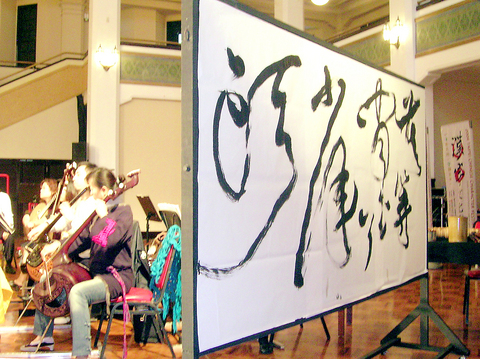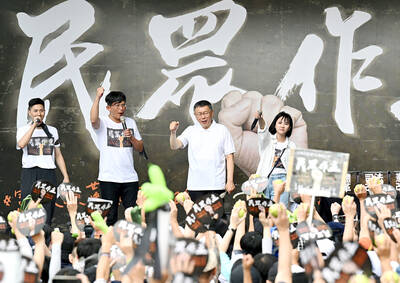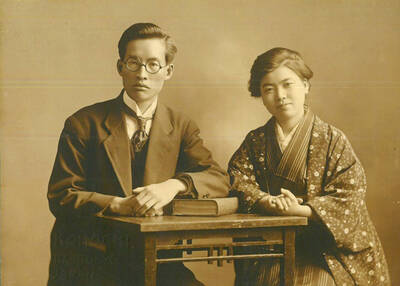Whether they make your heart beat faster or your head spin, Chinese characters are a powerful force to be reckoned with. Yet, as the world's most complicated writing system -- with its combination of pictograms, ideograms and phonetic signifiers -- Chinese script is under attack and has been for over a century.
The first-ever Taipei Chinese Character Festival is organized by Taipei city's Department of Cultural Affairs and examines the history and culture of as well as the present crises facing Chinese characters from academic, artistic and technological vantage points.

PHOTO: MEREDITH DODGE, TAIPEI TIMES
According to Liao Hsien-hao (
The month-long festival will kick off tomorrow night at
7:30pm with an outdoor multi-media concert in the plaza of the Ximending's Chungshan Auditorium. The concert will use a traditional Chinese orchestra for background music to which several master calligraphers will ink their different styles of characters on large sheets of paper.
The performance is designed to demonstrate how the act of writing a character can become like a dance in which each stroke has a different quality or emotion. However, unlike a dance, the performance produces a concrete work of art that allows viewers to reconstruct the calligrapher's movements as they examine each character. If this interactive performance can't show you how to appreciate the complex beauty of Chinese calligraphy, nothing can.
There will be plenty of opportunities for examining all kinds of Chinese characters at the festival's exhibition entitled Chinese Characters and Life. It will open on Dec. 31 at the National Museum of History. The exhibition will focus on four main topics.
One section will feature the five calligraphic scripts, each with its own historical and socio-cultural significance: the seal script (
Another section is devoted to the decorative function of characters, displaying a collection of everyday objects from tea utensils to weapons.
The calligraphic art section shows how the deceptively simple act of writing can become such a rich and highly developed art form, while the "Chinese character technology and modern art" section is sure to hold a few surprises. The exhibition will give visitors a chance to become acquainted with the historical and cultural aspects of something they see and use everyday. For example, did you know that there used to be a character set used only by women?
"Much of modern society considers Chinese characters to be a relic of the past," said Commissioner Liao at a press conference Tuesday. But the main point of the festival, he stressed, was not for Chinese culture to pat itself on the back for past glories.
The International Academic Conference on Chinese Characters and Globalization is planned for Jan. 28-30 at the National Library.
Liao said that the most important task for the conference was to identify and discuss the threats facing the Chinese writing system. Scholars and professionals from various fields will discuss the status of Chinese characters in the "Confucian sphere of influence," which extends throughout East and Southeast Asia. Although Japan is the only non-Chinese society that still uses Chinese characters in its writing system, both Korean and Vietnamese were written using Chinese (or Chinese-based) characters in the recent past.
What are the benefits or drawbacks of switching to Latin or phonetic scripts (as Korea and Vietnam) did or simplifying characters as China has? As the Chinese script that can be used to write very different languages, it has historically been a symbol of China's will to unite and rule "all under heaven." But in today's very different world, is the use of this ancient script still practical or meaningful?
Meanwhile, two competitions will give the public a chance to show off their love of Chinese characters, for better or worse.
The elementary school Chinese character competition will test youngsters' skill with idioms, variable pronunciations, etc. The first round will be held at various schools in Taipei on Dec. 29 and the final showdown will take place on Jan. 22 at Chungshan Auditorium. Call (02) 2371 0086 x 12 to sign up. The Chinese word-game software competition will award innovators with prizes of NT$100,000 for first place, NT$50,000 for second and NT$10,000 for third. Submissions are due Dec. 31 and prizes will be awarded on Jan. 22. Call (02) 2371 0086 x 9 to sign up or visit www.culture.gov.
Performance notes:
What: Taipei Chinese Character Festival Opening Concert: Flying Ink.
Where: Chungshan Auditorium Plaza, No 98 Yenping S Rd, Ximending MRT station exit 5
When: Tomorrow 7:30pm.
Details: Free admission. For more information on the festival, visit www.chinesecharacter.culture.gov.tw.

In the next few months tough decisions will need to be made by the Taiwan People’s Party (TPP) and their pan-blue allies in the Chinese Nationalist Party (KMT). It will reveal just how real their alliance is with actual power at stake. Party founder Ko Wen-je (柯文哲) faced these tough questions, which we explored in part one of this series, “Ko Wen-je, the KMT’s prickly ally,” (Aug. 16, page 12). Ko was open to cooperation, but on his terms. He openly fretted about being “swallowed up” by the KMT, and was keenly aware of the experience of the People’s First Party

Not long into Mistress Dispeller, a quietly jaw-dropping new documentary from director Elizabeth Lo, the film’s eponymous character lays out her thesis for ridding marriages of troublesome extra lovers. “When someone becomes a mistress,” she says, “it’s because they feel they don’t deserve complete love. She’s the one who needs our help the most.” Wang Zhenxi, a mistress dispeller based in north-central China’s Henan province, is one of a growing number of self-styled professionals who earn a living by intervening in people’s marriages — to “dispel” them of intruders. “I was looking for a love story set in China,” says Lo,

It was on his honeymoon in Kuala Lumpur, looking out of his hotel window at the silvery points of the world’s tallest twin skyscrapers, that Frank decided it was time to become taller. He had recently confessed to his new wife how much his height had bothered him since he was a teenager. As a man dedicated to self-improvement, Frank wanted to take action. He picked up the phone, called a clinic in Turkey that specializes in leg lengthening surgery — and made a booking. “I had a lot of second thoughts — at the end of the day, someone’s going

Aug. 25 to Aug. 31 Although Mr. Lin (林) had been married to his Japanese wife for a decade, their union was never legally recognized — and even their daughter was officially deemed illegitimate. During the first half of Japanese rule in Taiwan, only marriages between Japanese men and Taiwanese women were valid, unless the Taiwanese husband formally joined a Japanese household. In 1920, Lin took his frustrations directly to the Ministry of Home Affairs: “Since Japan took possession of Taiwan, we have obeyed the government’s directives and committed ourselves to breaking old Qing-era customs. Yet ... our marriages remain unrecognized,